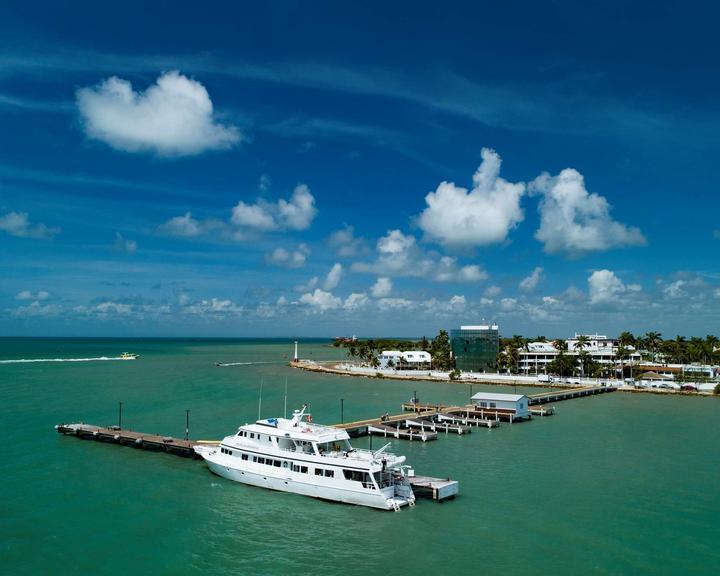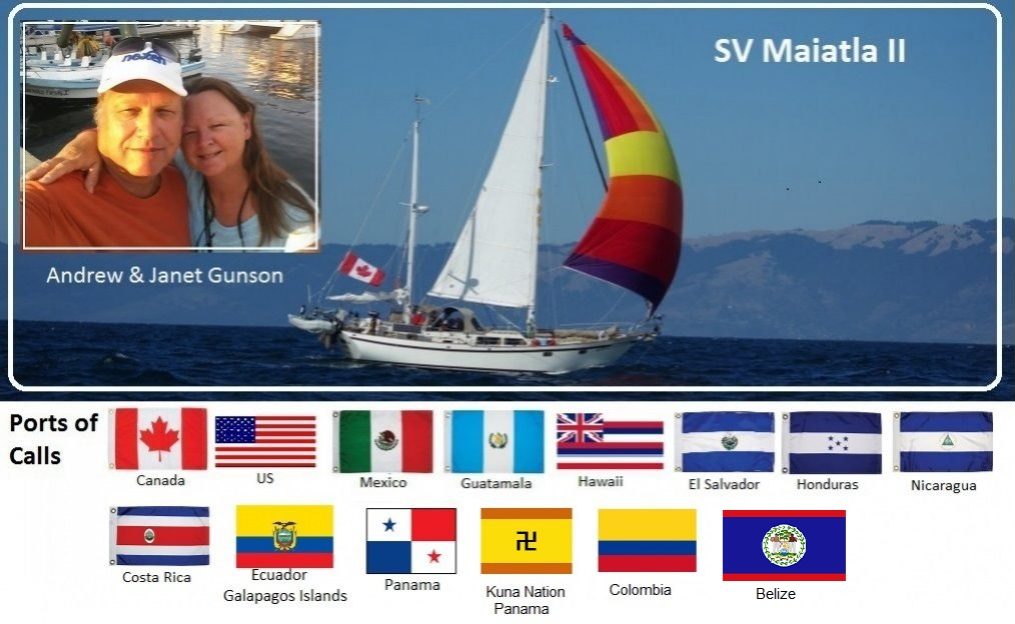
It was nice being at anchor again in Placentia but there still was much to do, a proper provisioning was one. Using the dink we went ashore to hit the stores and buy a few more parts and a tool that I deem essential on any cruising boat. A Dermal tool. My last one I had burned out on some project last year, which I sorely missed when having to hand file a new shaft key for the water pump.

By all accounts we were ahead of schedule, so much so I decided to push the time limits of my bond and explore a little of Belize while we had the chance. We were only 70 miles, as the Seagull flies from the most iconic site in all of Belize, the Blue Hole. Diving into the enigmatic depths of the Blue Hole has been on my bucket list since I was a teen and being so close, the temptation was far too great. So after a single night at anchor we were off bound for Belize City which lay some 65 miles to the north up the coast.

By first light we were underway. The winds were light so we motored until almost 11am when the wind finally filled in on the beam, making for a great sail. One of the most difficulty things I found with sailing in Belize was getting use to the shallow water, especially while traveling up through the many cays where having only 5 feet under the keel as was typical. But what made it more nerve-racking was seeing the many coral outcroppings that protrude up from a sand bottom only to terminate just below the surface.

In a sailor’s vernacular, these tiny pinnacles which may be just a few feet across or the size of a bus are referred to as “Bommies”, but I’m not sure that it’s the correct term or definition but these dangerous navigational hazards are rarely charted accurately and since they are a living organisms they are constantly changing in size and shape over time posing a real threat.
For the first part of the day we stuck to the deeper inner channel which cuts between the mainland and the outer barrier reefs. Despite being the main shipping route, depths again ranged from 30 to 70 feet with shallow, hull killing reefs dotted about.

Weaving Through the reefs,
By early afternoon I had to decide to where to anchor for the night so we found a cut into the reef and began to weave our way between reefs and cays and countless bommies. bound for Brown Bar, where it was reported to be a good anchorage and snorkeling.
It was wasn’t long before we had a close encounter with our first bommie making for a tense afternoon. The entrance into Brown Bar anchorage looked rather precarious to me so we passed it by to finally drop the hook in the lee of Man of War Cay to spend a quiet night at anchor. The island is not much more than a collection of mangrove trees on a shallow bank. Despite the lack of solid land the island plays host to nesting frigate birds.

The following morning we were up early and underway, weaving around reefs, cays and bommie infested waters as if navigating through a minefield. I felt a sense of relief in the early afternoon when we finally scudded out of the reefs to return to the main channel.

The Red squares are Bommies.
It was early afternoon when we decided to again anchor for the night. We chose Robinson Island where there was an abandoned shipyard and a wreck which was reported to be good snorkeling. Belize City was only about 5 miles away but I thought it best not to try and find a marina as dusk approached.
The anchorage proved to be a good one, calm with good holding and we anchored close enough to the wreck as to be able to swim over. The water was a bit murky but the wreck was a great snorkel with plenty of fish and places to explore.


We slept in and had a late breakfast before leaving for Belize City where I was about to learn that most of the marinas were of shallow draft, any vessel drawing more than 5 feet was out of luck. With Maiatla’s 6 foot draft, I only found two place to possibly go.
The Radisson Marine hotel looked like the most promising as it was almost down town and close to shopping but as we made our approach I was instantly disappointed. The dock sat atop piles so the incoming wind waves swept right under the dock with the top deck above Maiatla’s life lines. There was only a couple of locations where we could tie permitting us to put fenders down to protect the hull and naturally they were on the windward side of the dock which was exposed to the stiff trade winds and waves. Like a fool I gave it a try.

The Radisson Marina. We tied up in front of the large yacht.
The water shallowed as we approached giving more reason for concern. What if we run aground? I thought about aborting the approach but with the stiff wind at my stern I was committed. We bumped alongside with what must have been inches under the keel as my depth sounder was now reading 0 feet.
We were quickly approached by the dock master who cheerily greeted us but when he informed me of the price for a night’s moorage, I decided to bail. At $5 UDS per foot a night, it would be a whopping $250 USD. But at least they had free water on the dock. We had to wait for a slight lull in the wind to be able to push the boat off the dock so we could motor away. I Thought Easton was going to herniate himself as he shoved as I drove. The advantage of being captain.
We quickly headed back off into the bay to check the guides once more looking for a suitable marina, but I was interrupted by the arrival of a pod of dolphins who began to cavort around Maiatla. Easton was particularly thrilled as it was to first time to see these incredible animals in the wild. While we were snapping pics, I heard a call over the radio of a large cat calling Cucumber Marina, which was not far away.
After the yacht and finished talking to the marina manager, I called to ask if they had room for us. The nice lady said that they did but the marina was shallow with a mean depth of 6 feet. Since I was at a loss as to where else to go and that we had heard some good things about the marina, I thought I would give it a try.
The marina is located on the south side of Belize City which sits upon a large isthmus in a shallow bay, called Sibun Bight. My reasoning was that if we could not enter the marina, we could at least find shelter close to shore and out of the wind waves.
The approach was easy enough as the wind was light and off the stern with a water depth of around 9 feet, meaning that we had approximately 3 feet under the keel. All good so far, but that was about to change. We were less than a hundred yards away from the marina breakwater when suddenly the engine overheat alarm began to sound. A quick check of the gauges showed the water temp well into the red. I quickly shut down the engine and ran below for a look while telling Easton to turn the boat around and nose up into the wind.
It didn’t take long to see the problem, once again the raw water pump came apart as the pulley and belts had deserted into the bilge. It was not going to be a quick fix. I got on the radio and asked the marina manager if she could arrange a tow into the marina.
She was apologetic when she informed me they she did not have a boat capable of doing that, but she would call the coastguard for me to see if they could.
I told her to call the coast guard and see what they say, in the meantime I would start working on the engine. The manger reported back to me a few minutes later to inform me they said they would come when they had an opportunity. Whatever that meant.
I ran back on deck to find an anxious Easton trying to steer a boat with no forward motion. With the light wind now blowing us towards the rock jetty, I had no choice but to drop the anchor and fix the pump for the second time in three days. But at least I had a Dermal this time but it still took almost an hour to assess and make the repair.
At this time I came to the realization the nut which secures the pulley on the shaft was worn and was likely loosening up after some hours of use. As the nut backed off, the key tying the pulley to the shaft would slid out allowing the pulley to spin freely. It was a left hand threaded nut, an oddball of which I did not have a spare and finding one in town would probably prove daunting. The remedy for now would be to frequently check the tightness of the nut when underway. I inserted a new lock washer and some Thread seal ‘ Lock tight” in hopes of fixing the problem.
As I worked on the pump the wind and waves began to build and Maiatla commenced to hobby-horse in the now 6 foot waves making it difficult to work. With much relief the engine started and the temperature fell back to normal. Overheating an engine can do sever damage so it’s always a worry when it occurs.

Now the next problem was to see if the marina was deep enough to get in. As we passed in between the two sets of rock breakwaters, my depth sounder began to read 0. Looking back in my wake I could see a trail of mud raising to the surface as Maiatla plowed a trench in the soft bottom.

Safe at Cucumber Marina.
Once inside, I headed for the nearest open dock and with a great sigh of relief, I was able to come along side. As I threw the engine into reverse, a great cloud of mud erupted from under the boat. With lines now ashore, we had arrive at Cucumber Marina and what a great place it would prove to be. The Coast Guard never did arrive or even call on the radio to check on our condition, go figure.
